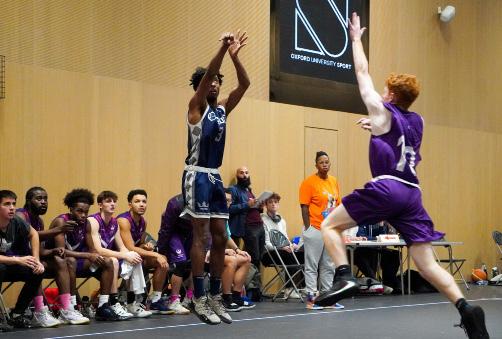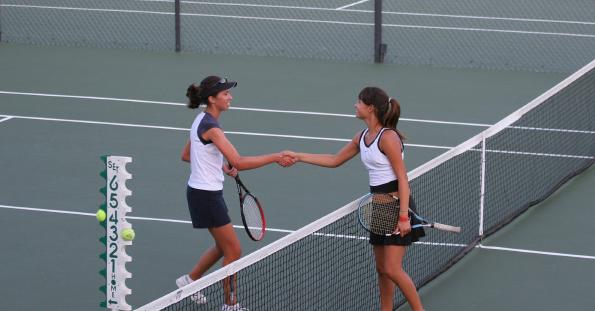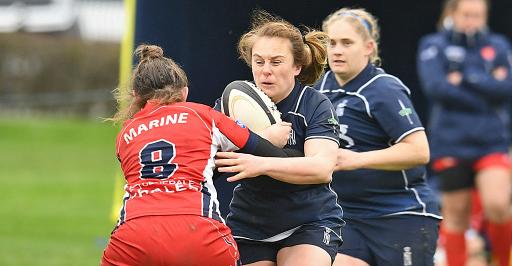
13 minute read
Oxford unpick keys and win the hallway dance as they waltz to victory
from MT2 Cherwell Week 7
by Cherwell
Calum Isaacs analyses Oxford University Basketball Club’s recent victory against Loughborough.
Oxford 92-68 Loughborough 4s
Advertisement
In a sports hall thronging with tens of people, the Equinox dance crew put on a halftime show. I know even less about dance than I do about basketball, so will not offer commentary on the routine. Yet, as they moved about in their various motions, I did think, “hm… I could do that… but that seems a bit cheap”. What I was thinking about was drawing some choreographic analogy with the game we were in the middle of.
But look, however crass this may be, I did see parallels. To be specifc, I saw three. The most obvious and simple symmetry came from the middle part of the show. The performers stood in a semi circle and individuals came forward and did what looked like freestyle, to varying success. This was the climax of the routine and it was up to the individuals to make it worthwhile.
The game this performance bisected certainly depended on individuals to make it worthwhile. For Oxford, it came down to a holy trinity: Josh Soifer, Orin Varley and Alex Koukouravas. Between them, they scored 76 of Oxford’s 92 points.
Josh, as I have covered previously, is a player with a particular skillset. He’s a power forward and has all the strength and tenacity to merit the name. He’s Mr Inevitable. Every quarter begins with a quick Soifer two-pointer. Every missed three is met with a Soifer rebound. He also gets into foul trouble, and, inevitably, the resultant forced absences are much noticed. For those periods he is missed, Oxford lose that sense of security, that sense that a fying ball will be met by a fying 6’5” Canadian.
The thing about Josh is that he can’t shoot from far, or, at least, he doesn’t. His currency is rebounds and drives. Early in the frst quarter, just as the teams were feeling out the rhythm of the game, he pulled off a drive to remember. Drives in basketball are both brutish and beautiful. And this where the second parallel with dance comes in.
The opposition ‘key’, the rectangular box below and in front of the hoop, is stuffed with opposition players, moving about at speed. A player that decides to drive to the basket has chosen a diffcult threesecond obstacle course. They must spin and feint and, yeah, dance their way through, unpicking that inscrutable morass. And once they’ve carved out the path, they jump and a defender jumps and in the air, they play chess. The shooter looks to pop it over the defender’s head but the defender starts moving his hand to block and the shooter instead, in an instant, moves his hand to one side and then the other and hits it round his opponent, and the chess match is over and the fate of the ball is up to the gods.
Up to the gods, yes. That is why the most hopeful of these shots are called ‘prayers’. But Josh’s shot was not a prayer—it was solid, and rehearsed. As it dropped in, I heard the loudest cheer I have heard at any of these games. I wish I had a photo of Josh’s face at that point. It contorted in such a passionate way that it’s hard to describe. The feelingout-the-rhythm thing was over. The tone had been set.
So, that’s Josh. The value of Orin and Alex is a bit different. Yes, they can drive. But they can also shoot. And ‘can’ in both of those sentences is used in a high threshold sense. Orin probably had a better overall game. He’s the captain, but his leadership style is not rowdy or tough. The shout he leads of ‘1, 2, 3, Oxford!’ before each quarter sounds more comradely than rabble-rousing. This is a style I think I’m instinctively disposed to defend as it’s also the only one I’m personally capable of. But it does feel like the Oxford dressing room is a comfortable and welcoming place, and I think Orin has his part to play in that.
It also helps that he’s pretty good at basketball. He seems to always pick up points in a fairly steady way. But, as Akin Akinlabi— an up-and-coming player slowly and surely gaining himself more game time—says after the match, if we made a highlight reel for this game, it would all be Alex. Alex is the starting point guard. My basic understanding is that a ‘point guard’ is the pivot from which everything stems. They control the tempo of the game, and direct people to the right positions for various plays. And for a point guard, Alex sure does a lot of pointing. Yet at the same time, he’s popping up on the left, or the right, shooting a perfect three, or he’s driving round one, round two, round three. Some of the drives and shots on the bounce he managed on Wednesday were so creative. He was in the dancing mood.
You might have noticed that I don’t talk about defence very much. That’s because I don’t really understand it. Drives are a dance, but it does take two to tango. And here is parallel number three.
The weird acrobatics of these sequences is down to the weirdness of the defensive rules. Basically, neither player is really allowed to make contact with each other. I mean you can, but not properly, not forcefully. So, the result is that the defender is actively trying to prolong a version of the awkward-dancewhen-trying-to-walk-past-someone-in-acorridor. The attacker moves one way and the defender anticipates and copies. The attacker moves the other way, so does the defender. That’s why it’s so important for a defender to ‘beat him to the spot’, i.e. get in the way quick enough.
Defence is this strange, jittery samba. You’re constantly trying to anticipate your opponent’s movements, and you can’t be too far (or they’ll shoot), and you can’t be too close (or they’ll drive past). What’s funny is when an attacker successfully dribbles round you, you kind of just have to let them go—which means that when a drive unpicks a defence, the mass of players that looked so intimidating is transformed into a group of men sheepishly giving way to you.
I think for proper basketball people, this will all sound fairly inane. ‘Weird dance? What are you on about?’ I mean I’m meant to be learning, developing my understanding. They say that over time, I should start being able to know whether a shot is going from the moment it leaves a player’s hands. Reader, I’ve tried… but that’s still defnitely not the case. They say I’ll probably build a connection with this team, and start caring about whether they win or lose. Reader, I have to admit I’m still more interested in the story than Oxford’s winning. W h a t
I did notice, though, in this match, is that my focus on offence over defence is partly a sign of develop m e n t . The Oxford attacks just seem to have more colour. Loughborough would come forward, and maybe they’d string some passes together, maybe they’d shoot a nice shot. But it all felt fairly routine—like they were getting points just to keep the game rolling on. When Oxford attack, I see characters and
Winning the hallway dance and waltzing to victory possibilities. I see Alex pointing, Orin shooting, and Josh fying in for the rebound. Of course, there are two levels on which to process the story in these games. There is this one, where it’s slowed down, where basketball is this waltz of fying and footwork. And then there’s the bigger picture, the context. This was a cup game. Oxford have progressed to the next round. And although this is the Loughborough 4s, they really are a decent team, which tells you something about what Oxford are up against if they want to get back to winning Championship games against Loughborough 1s—like they used to a couple of decades ago. This was a tough game and probably Oxford’s best performance of the season. It takes them to a 6-0 record this season, which, as I said last week, is the best form in over a decade. I don’t know on what level I will focus on the next match. It’s an away game at Brookes, “A PLAYER THAT DECIDES TO DRIVE whom Oxford narrowly beat a couple of weeks ago, but are expected to now be more TO THE BASKET HAS CHOSEN A DIF- in the fow of their season. Supposedly they have quite a few spectators at their games. FICULT THREE-SECOND OBSTACLE Supposedly this will be the hardest game of the season so far. But
COURSE. THEY MUST SPIN AND I also suspect I will fnd myself gravitating
FEINT AND, YEAH, DANCE THEIR back towards that other level of WAY THROUGH, UNPICKING THAT INSCRUTABLE MORASS.” On this day... interpretation, where the physical is supreme, where On 26th November 2017, British Formula 1 driver Lewis Hamilton claimed his 4th F1 World Drivers Championship Alex’s after finishing 2nd in Abu Dhabi, leading points are directing Sebastian Vettel by 46 points. a dance routine, a n d where everything pauses as Josh crashes towards the hoop. Image description: OUBbC’s Josh Soifer drives past a Loughborough player. Credit: Oxford University Basketball Club
Tennis, toilet breaks and Tsitsipas
Ariana Rubio discusses recent changes in ATP regulations on toilet breaks.
On the 31st of August 2021, Andy Murray tweeted: ‘Fact of the day. It takes Stefanos Tsitipas twice as long to go to the bathroom as it takes Jeff Bezos to fy into Space’. Nontennis fans were no doubt confused by the confusing collocation of the billionaire’s adventure in space and the Greek tennis player’s bathroom breaks. Tennis fans, however, would have immediately understood Murray’s not-so-subtle jibe at his opponent.
The day prior, on Monday the 30th of August 2021 at Arthur Ashe Stadium in New York, Murray and Tsitsipas faced each other in the frst round of the 2021 US Open. Murray took the two set with a dominant laed of 6-2, while Tsitsipas scraped a win in the second set with a very tight tiebreak score of 9-7. Murray took the third set 6-3, and lost the chance to close out the match when Tsitsipas came back to win the fourth set at the same score.
During the break between the fourth and fnal set, Tsitsipas took an extended toilet break – of eight minutes to be exact. This ffth set, which determined who would advance to the next round of the tournament, was possibly the most crucial juncture in the entire match. Complaining in a press conference after the match, Murray alleged that Tsitsipas’ long break was unsportsmanlike and disrupted the momentum of play. He later stated that, while ‘I’m not saying I would necessarily win that match [if Tsitsipas had not taken the break]’, this ‘had infuence on what was happening after’. At the time, however, this was well within ATP guidelines on toilet breaks. In a fve-set match, players were permitted to use the bathroom and change clothes during two breaks of unlimited duration at the end of a set.
Describing the ‘amount of time’ that Tsitsipas spent in the bathroom as ‘nonsense’, the British tennis player insisted that ‘I would have said the same thing if I’d won, I promise’. Given that Tsitsipas’ break was fully within ATP guidelines, one is tempted to tell Murray to stop his unsportsmanlike whinging. It should be noted, also, that the previously unlimited time for bathroom breaks was helpful for players on their periods and players suffering from digestive issues.
It is true, however, that a lengthy break off the court can help one compose oneself and come back to change the fow of play. Alexander Zverev, a German player on the tour who reached the semi-fnals of the championship, agrees. Prior to Murray and Tsitsipas’ US Open clash, Zverev had accused the latter of receiving illegal coaching during a lengthy toilet break. Noting that Tsitsipas took his phone to the bathroom and his father was texting in his box, Zverev alleged that the two were communicating.
Murray and Zverev were no doubt pleased to hear that the ATP Tour have now changed their regulations regarding toilet breaks. From now on, a clock will start when the player reaches the bathroom. Players will be allowed up to three minutes for a toilet break, with an additional two minutes available if they decide to change their clothes. They will incur a time violation, the frequent occurrence of which will lead to penalties, if they go beyond this limit. This is structured similarly to the guidelines regarding time between points, which state that players must begin their serving motion within twenty-fve seconds, and may lose a frst serve for repeated infractions.
Now at the end of the 2021 tennis season, which saw the reprisal of tournaments following the Covid-19 pandemic, the world of tennis eagerly awaits the next season. Fans will watch to see how this new regulation plays out on the court in 2022.

Sport Shorts...

Ole Gunnar Solskjaer sacked by Man United
On Sunday 21st November, Manchester United sacked manager Ole Gunnar Solskjaer following the side’s 4-1 defeat to newly promoted Watford. The sacking comes after a string of sub-par team performances, with the Red’s winning just one of their last seven games, leaving them trailing in seventh in the Premier League table, 12 points behind league leaders Chelsea. Games characteristic of this poor form include a 5-0 thrashing by Liverpool at the end of October, and a 2-0 defeat in the Manchester Derby, losing to Manchester City at the start of November. Appointed to replace Jose Mourinho on an interim basis back in December 2018, the Norwegian impressed Manchester United bosses with a collection of impressive results and was rewarded with a three-year contract in March 2019. He guided the team to a 2nd place finish in the Premier League last season and brought them to a Europa League Final where they eventually lost out to La Liga side Villareal on penalties, but ultimately it has been a poor run of form this season which has cost Solskjaer his job.
Speaking following his departure from the club, the former Red was visibly emotional, but remained philosophical in his reflections of his managerial spell. Speaking on how he feels to have had the opportunity to manage Manchester United, he reflected that he was “Very, very proud. Of course, it’s one of those things you dream of in your life.” Manchester United search for their new manager is already underway, with Brendan Rodgers and Mauricio Pochettino two of the current frontrunners. By Caitlin Murray

The relentless rise of The Red Roses
England Women’s rugby team crushed the USA 89-0 last weekend to round off an unrivalled year, extending their winning streak to an unbelievable 18 games. This latest result follows four consecutive comfortable international wins, including two crucial victories over current world champions New Zealand, meaning England finish this autumn with 239 points. For the first time in history, four consecutive England Women’s Tests were broadcast on terrestrial television outside of a World Cup, with over 1 million tuning into BBC 2’s coverage of the Red Roses’ win over Canada.
The Red Roses have cemented their status as the No. 1 ranked team in the world and are set to be favourites in the New Zealand World Cup next year. Twelve different players crossed the tryline with Lydia Thompson (Worcester Warriors), Lark Davies (Loughborough Lightning) and Sarah Bern (Gloucester-Hartpury) all scored twice as England racked up 14 tries against the USA. Full-back Abby Dow (Wasps RFC) was named player of the match on her 50th appearance for the team, having recently been nominated for the International Rugby Players’ Women’s try of the year following a stellar effort against France in April. Dow told The Guardian, “We rarely play four games in a row so to be able to go out there and perform like that and to keep the tempo we wanted is just incredible. It’s been a long process but all the training we’ve been doing is clearly paying off.”
By Georgina Findlay






